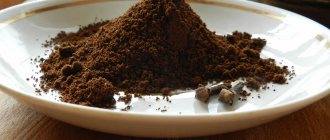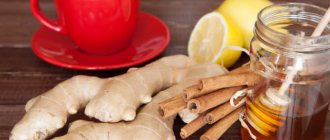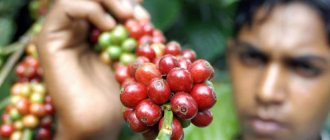Over the centuries-old history of coffee consumption, many recipes for this drink have appeared. In addition to mixing varieties, various spices are used to create an unusual taste. Easterners were the first to add spices to the invigorating drink. Spices in coffee change not only the taste, but also the properties: they neutralize caffeine, enhance the tonic effect, strengthen the stomach and nervous system, help warm up, relax and activate the brain.
Spices for coffee
Traditional seasonings that make the taste and aroma unusual are cinnamon, ginger, nutmeg, cloves, cardamom, vanilla and star anise. In addition to these, there are several more unusual additives, for example, bay leaf or salt, which also should not be ignored.
Cinnamon
Cinnamon coffee has a smooth, warming flavor that's great for colder seasons. Cinnamon reduces acidity, has a general anti-inflammatory effect, increases blood circulation, and reduces the risk of colds. Regular addition of cinnamon to coffee helps cleanse the blood, improves vision, maintains nervous system tone, and significantly improves mood. It’s better to add a small pinch of seasoning in powder form, and place the whole stick in a hot liquid, let it brew for a while, then take it out. A cinnamon stick can be used as a stirring spoon.
Carnation
A seasoning with a high content of essential oils, which makes the taste of the coffee drink tart and spicy. It is considered a “winter” spice because it has an antiviral, warming effect, improves digestion and activates brain activity. Cloves neutralize the effects of caffeine, but at the same time stimulate blood circulation. Maximum taste and benefits can be obtained by adding one head of cloves to hot coffee. Let it brew, remove the spice and enjoy the warmth of the unusual taste.
Ginger
A tasty and healthy supplement. Arabica beans or other varieties boiled with ginger soothe, relieve spasms, normalize the gastrointestinal tract, eliminate headaches and restore strength. Thanks to its warming effect and tart taste, ginger coffee eliminates apathy and energizes you. You can add the spice during cooking (a small circle of peeled root) or to a ready-made drink (a pinch of finely ground powder). While maintaining the coffee aroma, the taste becomes rich, reminiscent of the spicy, tart smell of sun-warmed thyme.
Vanilla
When making a vanilla latte or mocha, it is important to use natural flavoring and not a synthetic substitute. By adding vanilla pods or seeds, the invigorating drink acquires a mild taste, and also warms, relaxes, improves sleep and performance. Vanilla coffee with milk and vanilla relieves stress and restores strength. Natural seasoning is a strong aphrodisiac, so a cup of vanilla latte will be a pleasant addition to a romantic date.
When using vanillin, you can achieve a mild taste and aroma, but there will be no benefit from such a drink.
Star anise
Another option for a warming, tasty medicine. A few grains from star anise will be a useful supplement if you need to cure a cold, get rid of a cough or restore your voice. Due to the high content of essential oils, aromatic resins, tannin and sugars, star anise has an antispasmodic and carminative effect. Star anise calms and strengthens the nervous system. The spice should be added at the very end of cooking or to a ready-made hot drink. If coffee with star anise seeds is brewed in a Turkish coffee pot, then it is better to strain it when pouring it into cups.
Nutmeg
A very pungent spice with a bitter, astringent taste and a long aftertaste. Coffee with nutmeg warms, improves memory, treats vascular diseases and impotence. It has a strong tonic property. It is better to use ground nutmeg, adding a small pinch to a cup of drink. When using a whole nut, it is better to grate just a little on a fine grater or hand mill. It is important to remember the bitter taste of the seasoning and not to add too much, otherwise the coffee will be hopelessly spoiled.
Cardamom
Black invigorating coffee combined with cardamom is best drunk in hot weather - this spice has a cooling effect. This is a traditional drink for the inhabitants of North Africa, it is also called “Bedouin coffee”. The seasoning itself has a sharp taste and aroma that goes well with Arabica, but may be unusual for Europeans. Like other spices, cardamom is used in very small quantities, only for flavoring. For preparation, a special coffee pot with a thin, narrow spout is used, into which a cardamom box is inserted. The coffee flowing through the spout absorbs the aroma of the seasoning. Ground seasoning is used for cooking in Turk. Cardamom stimulates the spleen, strengthens the stomach, and also calms and improves mood.
Black pepper
It is more common to put black peppercorns in soup than in dessert drinks. But coffee lovers will appreciate the unusual taste. Coffee with pepper is an effective cure for colds, tonsillitis, sinusitis and bronchitis. It has a warming effect and has a strong antimicrobial effect. It also removes toxins, improves stomach function, metabolism and strengthens memory. Despite the antiseptic effect, drinking coffee with pepper during a sore throat is not recommended - the seasoning can increase irritation in the throat. Usually add 1-2 small peas to hot liquid and let it brew. It is not advisable to boil ground grains with pepper: the taste of the drink will become too spicy, even scalding. For the same reason, do not use ground pepper.
Allspice peas can be used as an additive.
Bay leaf
The beneficial properties of laurel have been known in medicine for a long time. It is an effective diuretic, antihypertensive and sedative. In combination with coffee, laurel leaves relieve chronic fatigue, improve the functioning of the nervous system and even save from depression. It is better to use fresh or dried leaves, adding them to a freshly brewed drink. The slightly infused liquid is filtered and the leaves are removed. Bay leaves a pleasant, light aroma.
Salt
An unusual additive that creates contrast, enhancing the taste and aroma of coffee beans. Salt replenishes mineral reserves, so it is a traditional additive in the Middle East. For the first experience of making “salty” coffee, it is better to use a fine grind, lightly sprinkling with a small pinch during the brewing process. Salt is used in combination with sugar, milk and other spices.
Citrus and other fruits
Coffee with lemon will no longer surprise anyone. The zest of orange, lemon, grapefruit or even lime gives an unusual taste and a very pleasant aroma, especially in combination with various spices. Apple pieces are also appropriate: the taste will be soft, with a subtle fruity sourness. When using fresh fruit, each coffee lover experiments for himself, choosing the components and their ratio to suit his taste.
Cocoa
Coffee with cocoa powder has a very soft, sweet taste with hints of chocolate, even without sugar. Add cocoa during cooking at the rate of 1 to 2 (two spoons of ground beans - 1 spoon of cocoa). This combination improves your mood, calms you down, and sets you in a positive mood, because it’s not for nothing that cocoa promotes the production of endorphin, the hormone of happiness.
Mint
Products that seem contradictory at first glance go well together. Toning coffee combined with the calming effect of mint results in a softer taste, pleasantly cooling and invigorating. Mint strengthens the nervous system and calms. Essential oils in mint relieve headaches. To prepare a mint Americano or latte, only fresh leaves are used, which are added during cooking. It is noteworthy that coffee with mint can be drunk cold, as it is very refreshing in the heat.
Chocolate for those with a sweet tooth
Regardless of the type of beans, you can safely add dark, milk or white chocolate to your coffee. The same applies to its type: grated, melted, broken into pieces or melted.
Interesting! How to clean a copper pot well at home
Depending on the flavor notes present in the drink, chocolate will help highlight them or create a new combination.
The mocha variety adds a bitter and milky appearance. In the first case, chocolate will add viscosity and tartness. In the second, on the contrary, it will soften the taste and add sweetness.
Coffee goes well with any form of sweetness. Don't be afraid to experiment and create your own variations.
Chocolate chips are sprinkled on top of the drink to give it an aesthetically complete look.
Combining coffee with spices: rules and recommendations
Whenever using aromatic spices, the main rule is moderation. The case of coffee is no exception. When first getting acquainted and experimenting with different additives, it is better to start with small quantities, one pinch is enough. It is better to use freshly ground spices, which are added at the end of brewing or to ready-made hot coffee. In the case of cinnamon, star anise, cardamom, pepper and bay leaf, use the whole seasoning, let it brew a little, take it out, and filter the drink. When using ground spices, it is better to grind them immediately before preparing coffee: this way the additives will retain the fullness of the taste and reveal the aroma. Loose seasonings are stored in airtight jars.
Do you like coffee with spices?
Yes
No
Spices go well with both single-origin coffees and blends of several varieties of coffee beans. If desired, you can add a mixture of several spices. It is important to ensure that the effects of the spices do not contradict each other. You need to be especially careful with seasonings that have strong tonic properties but do not neutralize caffeine. For example, coffee with ginger and cardamom will not only be unpleasantly spicy, but will also increase the strain on the heart. You can also buy ready-made seasonings for coffee or desserts, paying attention to the expiration date and storage conditions. If you do not quickly use a mixture of ground seasonings, the aroma, as well as all the beneficial essential oils, will simply disappear.
Peppermint essence for vigor
Mint syrup is used in the preparation of desserts and drinks. Thanks to the combination of flavors, the coffee turns out to be refreshing, but high in calories, up to 125 kcal. Consider this fact if you are on a diet.
Pour mint essence into the cooled finished drink. This will give it an interesting aroma.
Expert opinion
Vadim Kudryavtsev
Coffee expert, professional barista and simply in love with this aromatic drink.
Ask the barista a question
For a refreshing coffee experience, freeze some in ice cube trays and add before drinking. Sugar can be replaced with maple syrup.
Turkish coffee recipes with spices
It is best to brew coffee with spices in a Turk. Seasonings are added during cooking or to the finished drink. It is better to choose the volume of the Turk based on the number of servings required, so that everyone gets a cup of hot coffee and there is nothing left in the cezve. It is unpleasant to drink a cold drink, and when reheated, the beneficial properties of the seasonings will disappear. Clay Turks do not tolerate spices and other aromatic additives: the porous structure absorbs odors, which mix with further use.
Gingerbread coffee Tunisian style
Ingredients:
- finely ground coffee powder - 2 tsp. per cup of finished drink;
- cinnamon - 1 stick (3-4 g);
- cloves - 2-3 heads (2-3 g);
- cardamom - 1 box (2 g).
Preparation:
Pour coffee into a pot and add cold water. Add spices. Cook over low heat. When boiling, remove from heat and stir gently. Before serving, strain through a fine sieve.
Moroccan spiced coffee
Ingredients:
- ground Arabica or Robusta beans;
- ground ginger - 3-4 g per cup;
- ground cardamom - 2 grams per cup;
- ground cinnamon - 3 grams per cup.
Preparation:
Pour the ground grains with cold water and cook over low heat. To obtain a sharp, rich taste, add spices during cooking. If you put spices directly into a cup and then pour hot coffee infusion, the taste and aroma will be softer.
Coffee with cloves
The ground grains are poured with cold water and placed on low heat. When the first bubbles appear, the coffee is gently stirred and cloves are added at the rate of 1 clove per cup. Remove the boiling mixture from the heat, strain and pour into cups.
Nut powder
A cappuccino with the taste and aroma of hazelnuts will not leave anyone indifferent. Fans of other nuts can feel free to add them.
Take coffee beans and hazelnuts in a 2 to 1 ratio.
Roast the hazelnuts until the kernels darken. Use already roasted coffee beans or make your own. To prevent them from burning, do this one at a time, do not mix.
Grind both ingredients on a coarse grind setting in a coffee grinder. Place the finished mixture in a French press and cook until done.
Non-traditional supplements
Residents of some countries not only complement a hearty meal with a cup of coffee, but combine them...
For example, in Finland, cheese with a high fat content is cut into cubes, placed inside a coffee cup, and the whole thing is poured with a hot drink. A special treat is eating the gooey melted cheese with a spoon.
The Vietnamese use an equally original addition to coffee - sweet omelet. The beaten egg is mixed there not with cream, but with condensed milk. Pieces of the finished sticky omelette are dropped into a cup using a teaspoon.
Coffee goes well with any citrus fruits and fruits in general. Lemon, orange zest, coconut shavings are mixed with ground coffee and brewed. They give the drink an unusual aroma note.
In coffee shops you can sometimes find an unusual design for strong coffee foam: it is sprinkled with cocoa powder. Coffee and chocolate go great together.
In Finland, they drink coffee with the addition of special cubed cheese.











